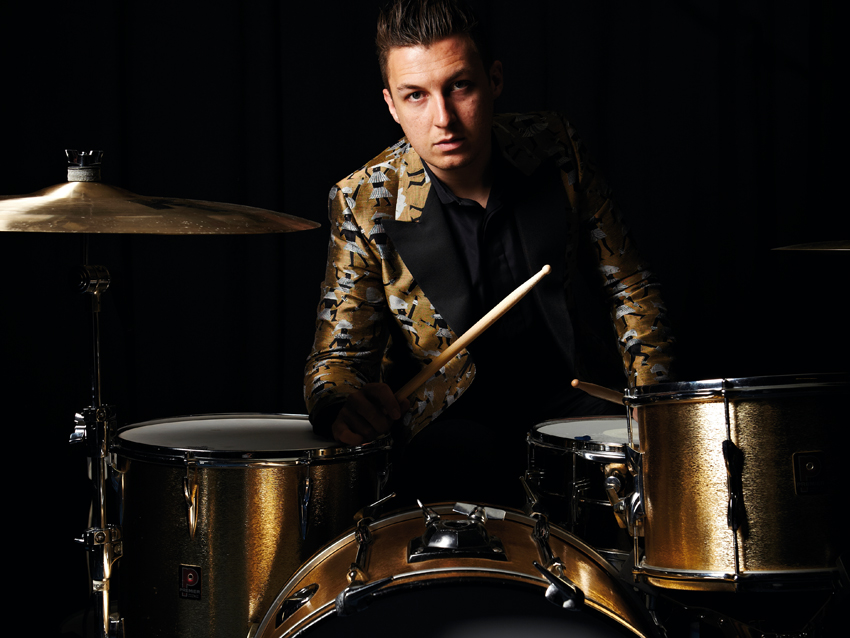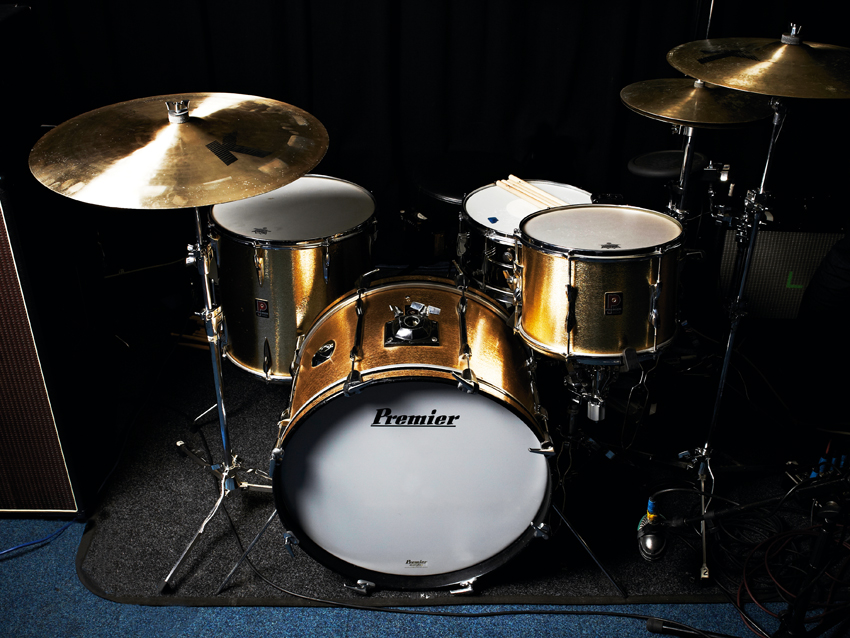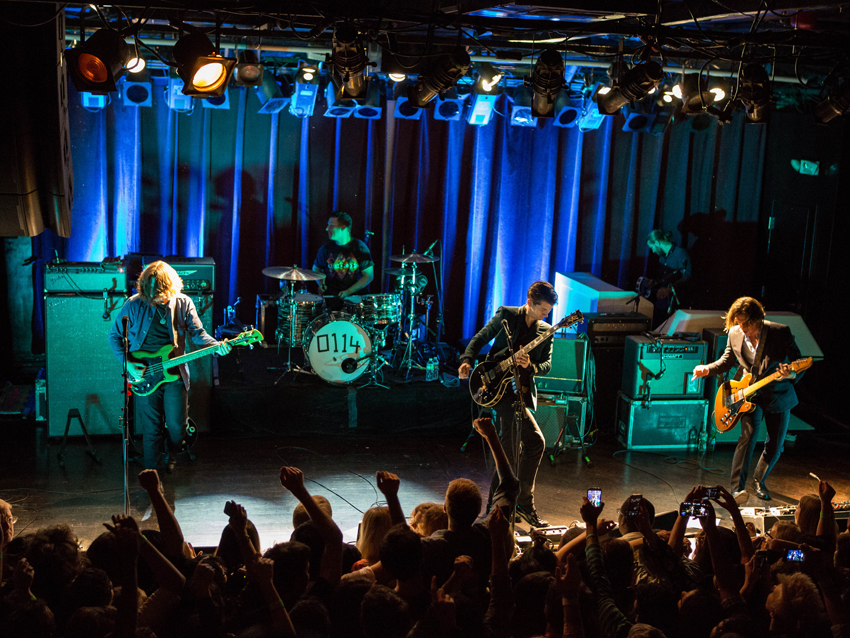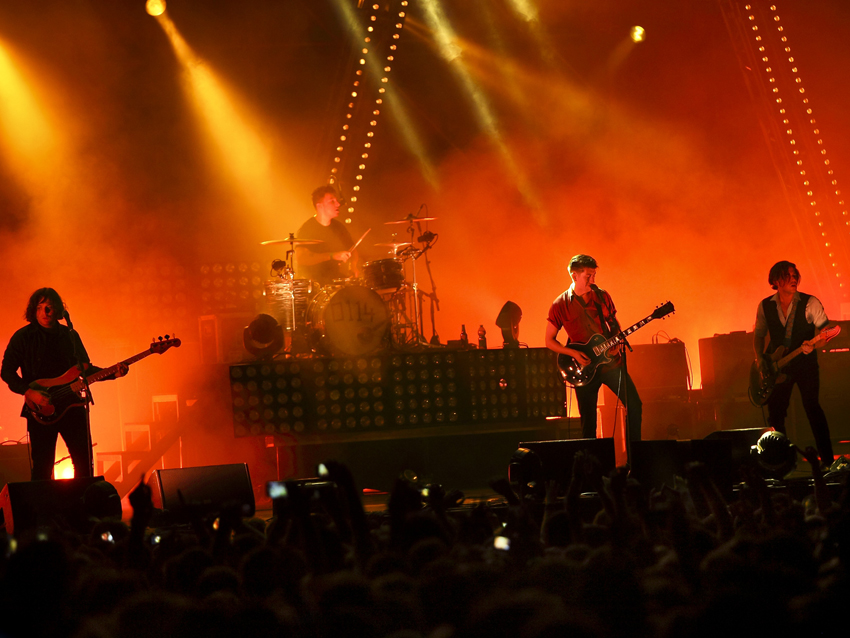Matt Helders' Arctic Monkeys drum setup in pictures
The world-conquering drummer on his kit and his playing style

Matt Helders' kit in pictures
The Arctic Monkeys are huge. Bigger, certainly, than the biggest thing to come out of Britain since the 1990s Britpop boom. You want proof, simply look to their defining headline slot at 2013’s Glastonbury, upstaging (possibly) even the Rolling Stones and (definitely) Mumford And Sons.
Last year, as Britain braced itself for the expected national embarrassment of the London 2012 Games, jaws duly dropped as the Arctic Monkeys took centre-stage of Danny Boyle’s impressive and upbeat Olympics Opening Ceremony.
The band’s fifth studio album, AM, landed earlier this year and, it has helped cement the band’s place as a truly Great British band.
Flying the flag, metaphorically and literally, from behind his Union Jack Premier kit, is Matt Helders. His energetic and fill-led approach to driving the Sheffield band’s wryly-observed rock has made him a favourite of drummers for some time, and his profile is such - thanks in part to his down-to-earth and likeable personality - that even the average non-drumming man-in-the-street knows that Matt Helders is Arctic Monkeys’ drummer.
Earlier this year, Rhythm met up with Helders (who has now relocated with the rest of the band to LA) in AM’s London rehearsal space to talk about the album and his progression as a drummer. Here we bring you choice snippets from that interview - which you can read in full in the October issue of Rhythm - along with pictures of Helders’ stunning, sparkling Premier kit.
- Find your next setup with our guide to the best drum kits

The kit
Premier: Gold sparkle vintage kit (as pictured): 22", 12", 16" Premier Series Elite in custom Union Jack finish: 14"x9" tom; 18"x16" floor tom; 24"x14" Gen-X bass drum; 14"x6 1/2" maple snare; 14"x6 1/2" Hammered Brass Modern Classic snare
Is there anything new you used in terms of gear for this album?
“In terms of kit we rented quite a lot of stuff. We always get asked why we record in LA. You can get any snare drum pretty much and you can get every amp - or if it’s broken, someone can fix it that day. There’s a lot of stuff for bands, or for anyone in entertainment - that’s what that place is for.
“So we hired a lot of stuff from Drum Doctor, he’s got a warehouse with everything in it, and he came and tuned my kit and made it sound probably the best it’s sounded. And he had a few snares. I use an old Black Beauty snare, but he had an older one that was a lot better, so it was putting all my stuff to shame.
“I like to use my own stuff as much as I can but I’m also not precious over it when it comes to the studio - it’s important to be a bit more open minded about it. And I suppose, going back to technique, it affected that as well because I was using more fragile drums and I couldn’t wack them like I could if I was on stage.
“I suppose it took me a while to get used to the idea that anybody can hit something hard. I used to think that was the coolest thing that I hit my drums as hard as I could, and I think that is a thing live - it looks good, or you just get into it and get carried away. But it doesn’t necessarily sound the best, it’s not the most impressive thing about drumming, and I probably thought it was for a while.
“So we had old marching snares and stuff that I couldn’t hit really hard. He said, ‘This is from the 1920s, please don’t play it like you normally would!’ Various different bigger bass drums, smaller bass drums. It was probably the most time we spent going through different tunings or changing the snare for each song, trying something different.”

Cymbals
Zildjian Dark K’s: 20” crash ride, 18” crash, 14” hi-hats
How do you think your drumming has evolved since Humbug?
“On that record I think I’d encourage myself to come up with a drum pattern I’d not heard on another song, I’d think it was weird just to play just a straight beat all the way through, and that’s gradually gone away a little bit because I’ve started thinking about how important it is to play for the song.
“I’ve managed to balance that so far, like do a mad drum beat but it still works for the song. On Suck It And See there’s still ‘Library Pictures’, that song was kind of a bit mad, but it was more like ‘song-y’ in a way, and that’s because of the way that was written. It was Alex on an acoustic then we applied all our parts. So the style that I played was, to the naked eye, simplified.”

Plus...
DW hardware (“I use the thinner 6000 series for the crashes as I like the vintage look but they still don’t collapse.”); Roland SPD-S
Helders on his Premier kits...
“The first good kit I had was a Premier kit for my 18th birthday, and obviously Keith Moon played Premier.
“When I started I didn’t know what each drum was called, I just loved the idea of being a drummer. Pearl was the drum kit that the one person I knew played drums had. I started looking into it and saw that Premier were a British company, and when I first had the opportunity to get a decent kit and saw they were being made in England I thought that was quite important, and they sounded good.
“My latest Premier kit is the Union Jack one I used at the Olympics and I’ve been touring that. It’s the first bigger kit that I’ve got. I always used the same configuration, 22", 13", 16", but I went 24", 14" and 18" which has been great, it sounds massive. It’s one of the ones that was made in England.
“I knew they’d done Union Jack before but I got a bit specific about it, even down to that I wanted the white of the Union Jack to be a bit darker so it looked like an old flag.”
Subscribe to Rhythm here for a monthly dose of new gear reviews, kit buying guides, pro drum lessons and all-star interviews.
Liked this? Now read: Drum kits of the pros: stars' live and studio drum setups in pictures









